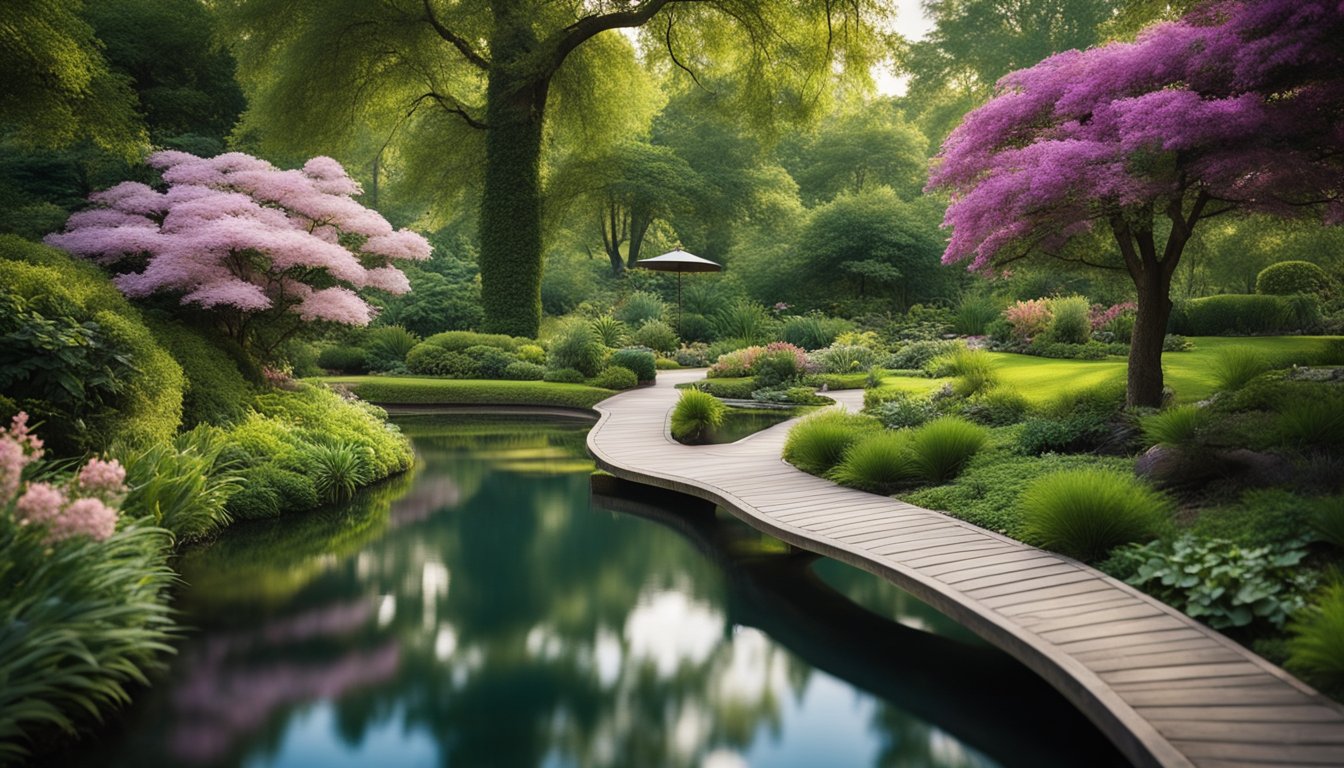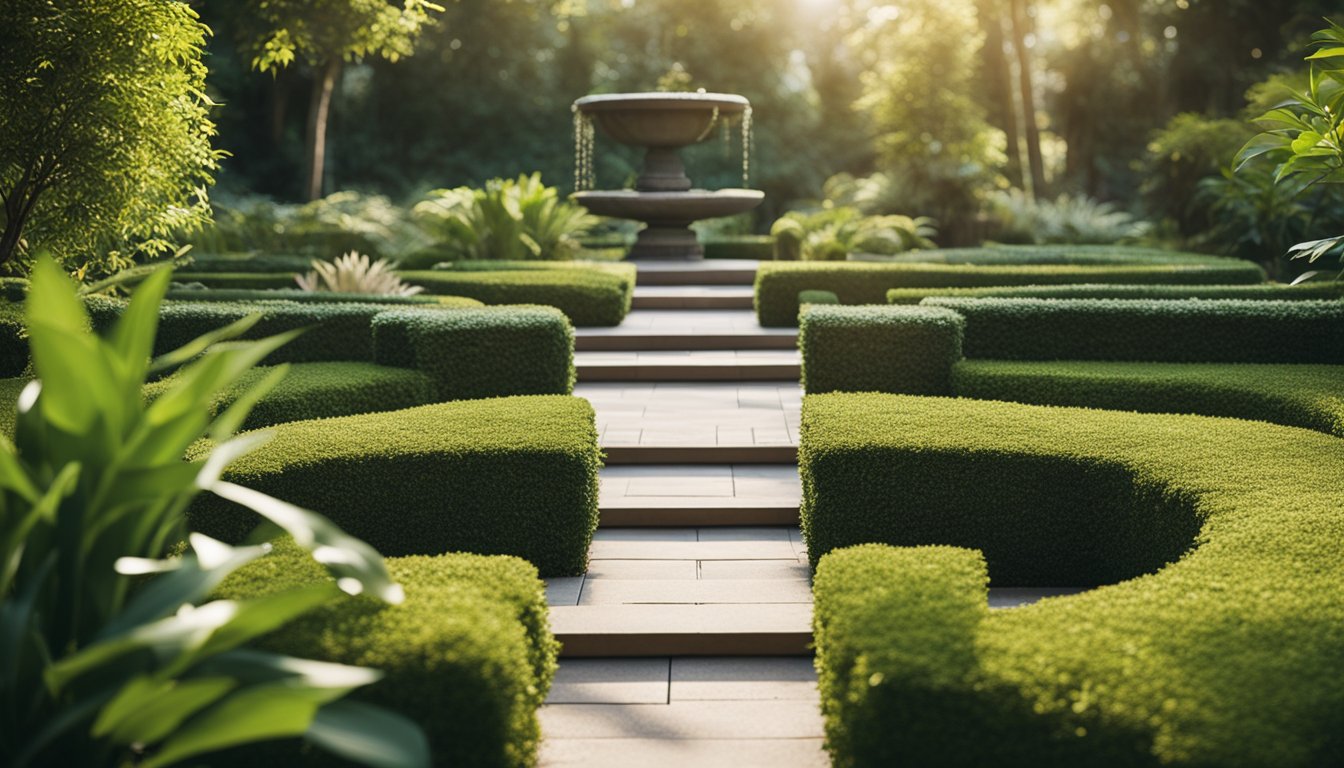Late updated: 03 May 2025 09:05
Written by: James Whitaker
Designing A Serene Garden Meditation Retreat: Crafting Your Tranquil Oasis
Designing a serene garden meditation retreat is about more than just landscaping; it creates a personal sanctuary where tranquillity and mindfulness harmoniously meet. By seamlessly blending natural elements, pathways, and calming centrepieces, we're able to transform any outdoor space into a personal refuge away from life's stresses. A well-designed garden can evoke peace, inspire reflection, and enhance relaxation in ways few other spaces can.

Incorporating features like water elements, lush greenery, and mindful pathways creates an inviting atmosphere for meditation and contemplation. Our aim is to cultivate a space that invites those who enter to pause, breathe, and reconnect with their inner selves. Whether in a sprawling backyard or a compact urban space, the essential principles remain the same: simplicity, natural harmony, and an intentional layout.
As we embark on this journey together to create your own meditation retreat, we'll provide insights and guidance on selecting key elements that foster serenity. Our exploration covers thoughtful planning, the essentials of tranquillity, and answers to common queries, equipping you to craft your space of peace and reflection.
Key Takeaways
- Design prioritises serenity and relaxation.
- Essential features include water and greenery.
- Planning is key to achieving a tranquil retreat.
Fundamentals of Designing a Serene Garden Meditation Retreat
Creating a serene garden meditation retreat requires thoughtful planning and design. It involves selecting the right site, incorporating key design elements, and ensuring a sense of privacy to foster a peaceful atmosphere.
Site Selection and Planning
Selecting an appropriate site is the foundation of a successful meditation garden. We should evaluate the topography to understand natural water flow and sunlight exposure. Ideal locations typically provide some level of existing natural privacy, such as hedges or trees.
A well-chosen site should be easy to access yet feel removed from daily distractions. We must consider practical aspects like proximity to utilities if enhanced features such as water elements are planned. Balancing nature with accessibility ensures a harmonious blend.
When planning, it is important to incorporate the existing natural landscape. Working with the environment, rather than against it, promotes sustainability and encourages the garden to evolve as a dynamic space.
Key Design Elements for Meditation Spaces
Incorporating elements that foster balance and tranquility is crucial. Utilising rocks, sand, and water offers both visual appeal and sensory engagement. Water features like ponds or small fountains can introduce soothing sounds and a sense of serenity.
Paths of gravel or stepping stones guide movement and encourage mindful walking. Arranging seating areas with natural materials such as stone or wood enhances comfort while aligning with the outdoor theme.
To establish biodiversity, we integrate native plant species that require minimal maintenance. Such choices not only support local ecosystems but also create dynamic seasonal changes, enriching the meditation experience.
Creating a Sense of Privacy and Sanctuary
Shielding the meditation garden from external noise and interruptions enhances its restful qualities. Hedges, bamboo fences, or trellises with climbing plants offer natural barriers. These elements not only block visual distractions but also absorb sound, improving the retreat-like atmosphere.
Creating subtle boundaries through changes in elevation or texture, such as distinct ground covers or natural dividers, reinforces a sense of enclosure. The layout should ensure that spaces feel intimate without being claustrophobic, allowing users to feel both connected to nature and secure.
Our focus is on creating a sanctuary where one can unwind and reflect, achieved by thoughtfully balancing separation with openness and using the natural elements to foster a feeling of peace.
Essential Features for Tranquil and Mindful Garden Retreats

Creating a garden meditation retreat requires specific elements that promote tranquility and mindfulness. By integrating lush greenery, calming water features, soothing soundscapes, and inviting seating areas, we can cultivate an environment that nurtures peace and relaxation.
Incorporating Lush Greenery and Native Plants
Greenery forms the backbone of our garden retreat, offering a natural sanctuary. By incorporating lush greenery, such as ferns and bamboo, we create a sense of seclusion. Native plants are particularly effective as they adapt well to local climates, needing less maintenance and watering.
Including lavender, chamomile, and jasmine not only adds colour but also releases calming scents. These aromas enhance the meditation experience, encouraging relaxation. Bonsai trees can serve as striking focal points, providing beauty and sparking contemplation.
Using a variety of greenery, from tall shrubs to ground covers, helps in shaping different garden areas, creating interesting visual layers. It's essential to maintain a colour palette that is soothing, using calming colours and avoiding clashing hues.
Integrating Calming Water Features
Water features, like fountains and small ponds, are vital in establishing a meditative ambiance. They introduce a natural element to our retreat, providing visual interest and a soothing backdrop. The gentle sound of flowing water is both calming and a natural stress reliever.
Positioning water elements where they catch natural light can create beautiful reflections, adding to the visual appeal. We can enhance these features with decorative accents like rocks, sand, or gravel, imitating a natural setting.
Pathways of smooth stones or timber can guide the way to these water features. Such paths ensure the sound of water reaches us even before the feature comes into view, setting the scene for contemplation.
Soothing Soundscapes and Acoustics
Creating a relaxing soundscape involves more than adding water elements. Wind chimes are an excellent choice, offering gentle acoustics that create a sense of movement in the garden. They can be crafted from materials like wood or metal, each producing unique tones.
It's crucial to consider the acoustics of our space. Natural barriers, such as bamboo or hedges, can help buffer unwanted noise from surrounding areas, keeping the retreat serene.
Additionally, we might incorporate soft background music or essential oil diffusers that release tranquil scents and resonate with the natural vibes. Varying sound levels provide dynamic auditory experiences, avoiding monotony.
Inviting Seating and Contemplation Areas
Comfortable seating is crucial for prolonged reflection. Using natural materials like wood or bamboo for benches blends seamlessly into the environment. Cushioned seating with a minimalist design provides comfort without distracting from the meditation practice.
Seating areas strategically placed offer interactions with different garden elements, from lush greenery to soothing water. These areas can be enhanced with scented candles or lanterns, casting a soft glow that is relaxing in low light conditions.
Frequently Asked Questions

In designing a serene garden meditation retreat, it is vital to consider both the physical and sensory elements. This involves selecting the right plants, utilising water elements, employing environmentally friendly practices, budgeting wisely, and ensuring privacy.
What are the essential elements to include when creating a tranquil garden meditation space?
To cultivate tranquillity, incorporate natural elements such as lush greenery and vibrant flower beds. The presence of smooth stones, comfortable seating, and mindful pathways enhances the meditative experience. These features should harmonise with the natural surroundings, creating an inviting and peaceful atmosphere.
How can one incorporate water features to enhance the serenity of a meditation garden?
Water features like fountains or small ponds add calming soundscapes, which help drown out external noise and promote a sense of peace. Careful placement, avoiding areas prone to evaporation or debris accumulation, ensures the water remains a beneficial, low-maintenance feature.
What considerations should be made regarding plant selection and placement for a meditation retreat?
Selecting native plants that are easy to maintain and thrive in local conditions is ideal. Arranging them to create shaded areas and natural boundaries enhances privacy and seclusion. Layering different heights and textures can add depth and interest.
Could you suggest environmentally friendly practices for maintaining a peaceful garden sanctuary?
Utilising rainwater harvesting systems and choosing drought-resistant plants can significantly reduce water usage. Organic mulches improve soil health without chemical fertilisers. Solar-powered lighting provides efficient energy use, while composting supports sustainable waste management.
What budget should be anticipated for establishing a meditation garden retreat?
Costs can vary widely based on size and features. A modest garden focused on essential elements could be achieved with a smaller budget, whereas customised features like extensive water systems or high-quality materials will require more substantial investment. Precise planning helps align costs with expectations.
How can privacy be optimised in a garden designed for meditation and reflection?
Utilising hedges, fences, or trellises with climbing plants can provide effective natural barriers. They shield the space from outside views, creating a secluded environment. Sound barriers, such as dense shrubbery or strategic spacing, help minimise noise, enhancing the retreat's solitude.
